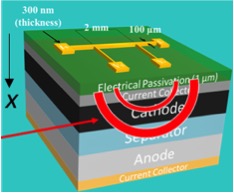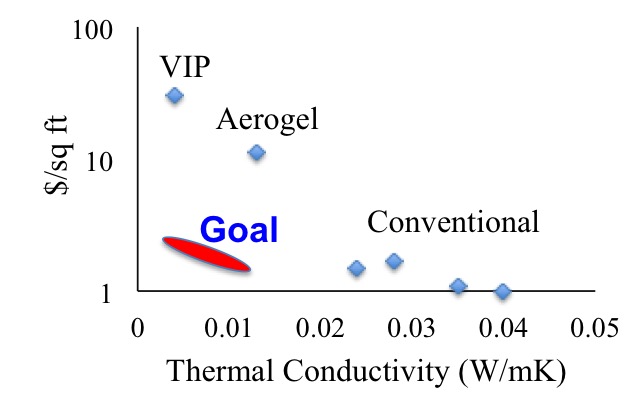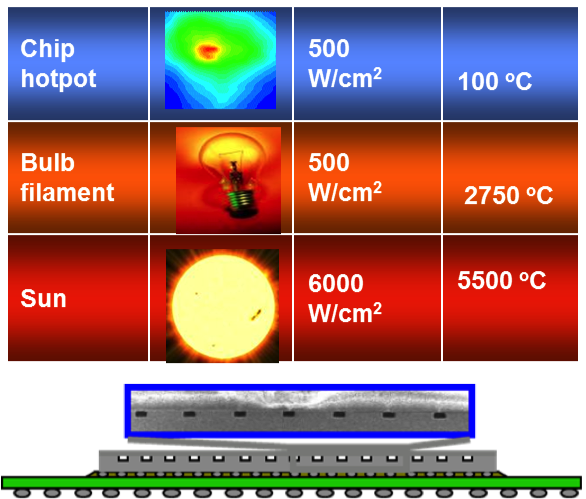Thermal Management
Thermal Management of Batteries, Microelectronics and Buildings
In-operando Thermal Characterization Lithium-ion and Beyond Lithium-ion Batteries
 Effective heat dissipation in batteries is important for a variety of reasons, including performance, reliability, safety, and fast charging. Currently, the thermal management of battery cells is provided at the system level using external cooling equipment, resulting in complex system level designs and reduced effective energy densities. Our research is focused on providing battery cell materials-level thermal solutions by enhancing thermal transport material properties. Our approach is to: 1) Identify thermal bottlenecks in Li-ion batteries during operation; 2) Explore various techniques to minimize the identified thermal bottlenecks without compromising electrical performance 3) Detecting onset of lithium plating. This project is funded by DOE Vehicle Technology Office.
Effective heat dissipation in batteries is important for a variety of reasons, including performance, reliability, safety, and fast charging. Currently, the thermal management of battery cells is provided at the system level using external cooling equipment, resulting in complex system level designs and reduced effective energy densities. Our research is focused on providing battery cell materials-level thermal solutions by enhancing thermal transport material properties. Our approach is to: 1) Identify thermal bottlenecks in Li-ion batteries during operation; 2) Explore various techniques to minimize the identified thermal bottlenecks without compromising electrical performance 3) Detecting onset of lithium plating. This project is funded by DOE Vehicle Technology Office.
Heat Generation in Extreme Fast Charging Batteries
 For enabling fast charging, effective heat dissipation is critical. In particular for fast charging a recent paper by researchers from NREL, INL and ANL showed that current system level cooling solutions alone cannot provide sufficient cooling and thus the effective thermal conductivity of the Li-ion cell has to be increased. Measurement of q(x)and k(x) for various fast charging conditions using the 3-omega sensor by running it both in DC and AC mode. In the DC mode it serves a temperature sensor whereas in AC mode it enables the measurement of k(x). By running the sensor in AC for various fast charging conditions k(x)as a function of charging rate can be obtained. By running it in DC mode the temperature of the cathode side and the anode side current collectors can be measured.
For enabling fast charging, effective heat dissipation is critical. In particular for fast charging a recent paper by researchers from NREL, INL and ANL showed that current system level cooling solutions alone cannot provide sufficient cooling and thus the effective thermal conductivity of the Li-ion cell has to be increased. Measurement of q(x)and k(x) for various fast charging conditions using the 3-omega sensor by running it both in DC and AC mode. In the DC mode it serves a temperature sensor whereas in AC mode it enables the measurement of k(x). By running the sensor in AC for various fast charging conditions k(x)as a function of charging rate can be obtained. By running it in DC mode the temperature of the cathode side and the anode side current collectors can be measured.
Manipulating Thermal Transport to Make Super Insulation
 Heating and cooling of buildings consume ~15% of the primary energy in the United States. High-performance and cost-effective thermal insulation can significantly reduce cooling and heating loads. We are manipulating heat transport using nanoparticles and nanoscale interfaces to create economical super thermal insulation. Interfaces between materials disrupt heat flow by scattering phonons and reducing their mean free path (MFP). This effect is amplified in nanostructured materials due to their high interface densities, enabling them to achieve super low thermal conductivities while still retaining high solid volume fractions (>50%) that provide high mechanical strength. This project is funded by DOE Building Technology Office.
Heating and cooling of buildings consume ~15% of the primary energy in the United States. High-performance and cost-effective thermal insulation can significantly reduce cooling and heating loads. We are manipulating heat transport using nanoparticles and nanoscale interfaces to create economical super thermal insulation. Interfaces between materials disrupt heat flow by scattering phonons and reducing their mean free path (MFP). This effect is amplified in nanostructured materials due to their high interface densities, enabling them to achieve super low thermal conductivities while still retaining high solid volume fractions (>50%) that provide high mechanical strength. This project is funded by DOE Building Technology Office.
Microelectronics Thermal Management Using Microfluidics
 The goal of this project is to conduct research in the area of thermal management of microelectronics. Highly efficient thermal management is critical for the performance and reliability of microelectronics. The increased integration density of electronic components—including 3D chip stack technology—has increased the thermal management challenges for microelectronics. Confluence of chip power dissipation above 100 W with very high localized hot spot fluxes and package-level volumetric heat generation greater than 1kW/cm3 have made thermal management very challenging. The conventional cooling architectures using thermal conduction spreading and heat sinks cannot provide adequate thermal management. In this project we are developing advanced liquid based microfluidic cooling that will have widespread use spanning planar to three-dimensional chip architectures.
The goal of this project is to conduct research in the area of thermal management of microelectronics. Highly efficient thermal management is critical for the performance and reliability of microelectronics. The increased integration density of electronic components—including 3D chip stack technology—has increased the thermal management challenges for microelectronics. Confluence of chip power dissipation above 100 W with very high localized hot spot fluxes and package-level volumetric heat generation greater than 1kW/cm3 have made thermal management very challenging. The conventional cooling architectures using thermal conduction spreading and heat sinks cannot provide adequate thermal management. In this project we are developing advanced liquid based microfluidic cooling that will have widespread use spanning planar to three-dimensional chip architectures.